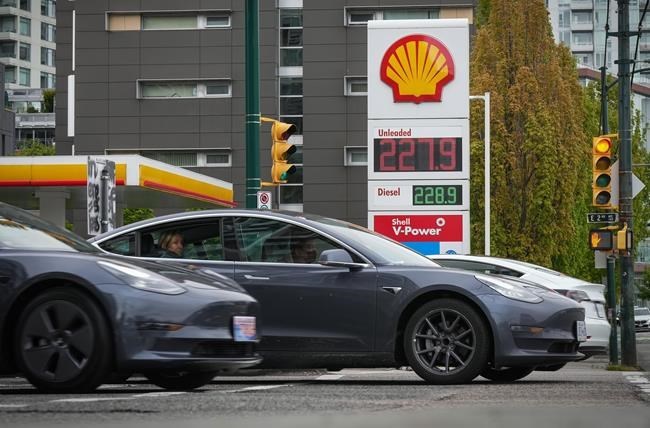CALGARY — There's a famous saying that 'the cure for high prices is high prices,' but when it comes to gasoline, that may not necessarily be the case.
Experts are torn on when or even if drivers might see significant "demand destruction" — an economics term for a sustained decline in demand for a product due to excessively high prices — at the pumps.
In theory, reaching an unsustainable price would serve as a tipping point and ultimately cause fuel prices to fall, finally offering drivers some relief. But analysts say we're not there yet even though gas prices are hovering around all-time highs.
"Canada’s gas prices are at inflation-adjusted records. But I continue to be astonished at the high level of demand we’re seeing," said Patrick De Haan, head of petroleum analysis for the fuel price tracking service GasBuddy.com.
Gasoline prices have been rising since February, ever since Russia's invasion of Ukraine sent shock waves through international energy markets.
On Thursday, the national average retail price at the pump in Canada was 208.5 cents per litre, a whopping 76 cents higher than last year's average of 132.2 cents per litre. The country hit an all-time record of 210.8 cents per litre on June 12, according to GasBuddy.
While Canada doesn't have good statistics on consumer fuel consumption, De Haan said gasoline purchases are likely comparative to the U.S., where federal data shows gasoline demand has backed off only about five to 10 per cent since prices first began to spike earlier this year.
He said that's surprisingly low, but likely has everything to do with the lifting of COVID-19 restrictions.
"I would have expected to see more demand destruction (in Canada) at the $2 a litre mark," De Haan said. "But I think that many Canadians, similar to their American counterparts, are wanting to get out. I also think there are more Canadian companies that are going back to a physical office, and that could be a reason why we’re not seeing things fall off more significantly.”
De Haan added he believes it would take prices climbing as high as $2.25 or $2.50 per litre for unleaded fuel — something that's unlikely, but could happen if a natural disaster or weather event took out a major North American refinery this summer — to trigger "exponential" levels of demand destruction. Diesel fuel recently peaked at around $2.50 per litre.
Ian Jack, vice-president of public affairs for the Canadian Automobile Association, said any demand destruction that's taking place at this point is likely minor. He pointed out that for many Canadians, especially in smaller cities and rural areas, driving is the only way to get to work.
“People who drive, by and large, can't just stop driving," he said. "So we really see this (price spike) as only affecting demand on the margins."
While a small number of Canadians may change their summer vacation plans due to high gas prices, Jack said many will be reluctant to if they spent the last two summers staying home because of COVID-19.
"Jet fuel and airfares have gone up as well. That means if you’re looking at doing a summer vacation, I don’t know that deciding not to drive and taking the plane instead is going to save you any money," he said.
However, Vijay Muralidharan, managing director of R CUBE Economic Consulting in Calgary, is less confident that the current high prices can be sustained by consumers for long. In fact, he believes significant demand destruction is happening already.
“In my analysis, when the average price goes past $1.80 and stays there a while, demand destruction occurs. So it’s already happening in Canada,” he said.
The reason that pump prices in this country aren't yet reflecting a reduction in demand, Muralidharan said, is that U.S. driver demand is still so high. Because North American fuel refiners have the option to sell into either the Canadian or U.S. markets, as long as demand remains high south of the border, fuel prices in this country will remain elevated.
In fact, the performance of the U.S. economy is the "biggest barometer" to pay attention to when watching for early signs of gasoline price demand destruction, Muralidharan said.
Up to now, he said, real U.S. disposable incomes have remained high, but inflation and recent interest rate hikes by the Federal Reserve make it likely that consumer buying power in that country is about to take a dive.
"Real incomes are not rising as fast as inflation, (therefore) you will see some sort of pullback in demand," he said. "My prediction is that by end of July, early August, we will see some sort of (gasoline) price reprieve."
This report by The Canadian Press was first published June 17, 2022.
Amanda Stephenson, The Canadian Press



